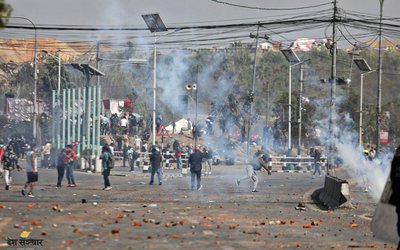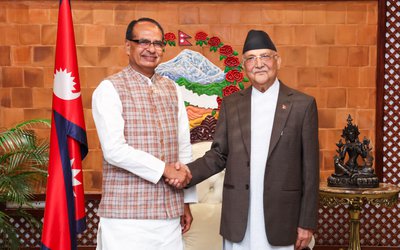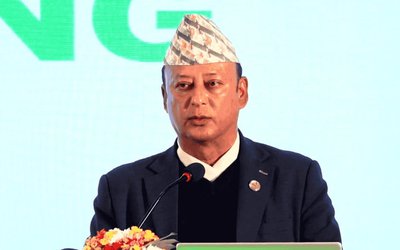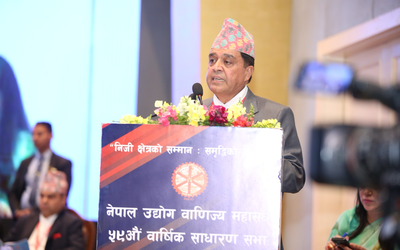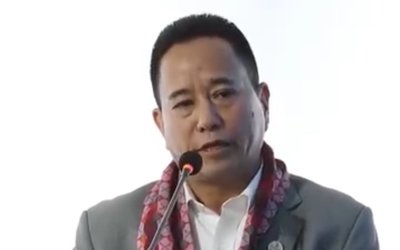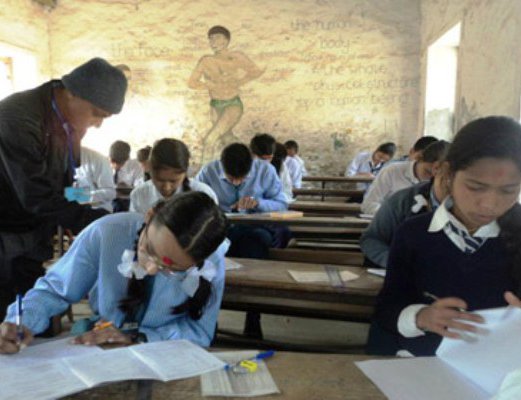
Over 82 percent students passed out School Leaving Certificate (SLC) from Bajrabarahi Higher Secondary School this year. Similarly, 89 percent students passed out from Chandeswori High School of Banepa.
If we look at the records of these two public schools in the past, their pass percentages were 30 percent on average for the last one decade. At a time when school facilities, quality of teachers and other academic aspects remain the same, a common question is: how did these two public schools, for example, double their results in a matter of a year?
Looking beyond the two schools, teachers of public schools all over Nepal have reasons to rejoice as they were able to pass out over 90 percent students without making any changes in the curriculum, teaching and learning practice and physical environment. This is a bonus they got without making any investment.
With the decision to reduce the pass marks from minimum 32 to 20, the entire results system has changed. If Minister for Education Giriraj Mani Pokharel reduced the pass marks to change the entire results, what is wrong for another minister next year to announce a system with hundred percent pass rate?
This year’s decision is likely to have a long term implication for the education system in Nepal. In the past, except in 1951 when SLC Board declared hundred percent pass rate in S.L.C, this year is the first time political leaders prevailed over SLC results.
Private Schools
This is a bumper harvest year for public schools as they achieved a success without making any additional effort and investment in the education sector. This is not so with the private schools.
With hard efforts and dedication of members of Legislature Parliament Dr. Baburam Pokharel, founder of Vinayak Suda Niketan High School, which has been able to secure 100 percent results in the last two decades, secured a similar rate with all the students securing A+ and A.
The high pass rate of students in all the examinations by private schools like VS Niketan is understandable as they put a lot of efforts on the students' education, involving cost and dedication.
Similarly, GEMs and Galaxy and other private schools produced hundred percent pass rate with most of their students securing A+ and A. All these private schools have put a lot of efforts on their teaching and learning environment.
Despite the equal pass rates of public and private schools, disparities in quality of education will continue as the private sector will need to be competitive and qualitative to survive. However, public schools will get the funds for whatever be the quality of education they provide.
According to the new system, no student appearing in the SLC gets a ‘fail’ certificate. The system of awarding fail and pass marks in each subject to the SLC students has been in practice for the last 80 years since the first SLC exams took place in 1934 AD. This is now replaced by a grading system.
There are five categories in marking. According to the new system, students will be awarded A+ (90 and above per cent), A (80-89 per cent), B (60-79 per cent), C (40-59 per cent), D (25-39 per cent) and E (below 25 per cent) grades.
Confusion Galore
Even students, who passed out SLC, don’t know why they got their A+, A, B, C or D grades? What do these mean for them? Not only the students, even Minister of Education Giriraj Mani Pokharel does not know what type of grading system Nepal introduced? Is it like the grading of United Kingdom, United States, Canada, Australia, India, Sri Lanka or Pakistan? How will other countries compare the Nepalese grading system?
“We changed the system slightly to break the myth that SLC is an Iron Gate. Our grading system follows the national context as we cannot keep such a large number of students out of higher education just on maintaining rigidity in examination evaluation. Nobody can dictate us how we should evaluate our education system,” said Minister Pokharel.
Although the Minister is proud for the change made as per his own decision, it will have long term implications in the Nepalese education sector as well as at the universal level. Minister Pokharel and his team were able to destroy Nepal’s education system, which had remained intact even during the bloody Maoist insurgency, when insurgents targeted the education institutions.
“We are jubilant on the SLC results without knowing that nothing has changed in the last one year in the education sector to improve the results from 37 percent to 97 percent,” said Govinda Raj Joshi, former minister of education. “Since education is universal, our system also needs to be worth recognition universally.”
Farewell to SLC
With the results of School Leaving Certificate (SLC), Nepal bid farewell to the 10-year schooling system that had been in practice for more than eight decades. The new education act paves the way for school restructuring, as per which, from next year onwards, a 12-year school education system will be in practice.
Here again so much confusion prevails. At a time when infrastructure in public and private schools for 11 and 12 grades is inadequate, the school systems have to face bigger challenges.
From recruiting teachers to class rooms, nothing is ready as yet. As the annual budget allocated in education sector has not changed much compared to the last year, it will add financial difficulties.
As the number of students passing SLC has gone high, the existing colleges will have to bear more than twice the burden of students. More colleges, almost double the current number, will be required to accommodate all those who have passed SLC this year.
Education is Universal
As education is universal, it needs to be endorsed by different countries of the world. Nepalese system cannot remain a pariah. The institutions which regulate education at higher level are universities.
Given the present state of education, it is uncertain how the countries around the world will treat Nepal’s change in examination patterns. Even Nepal has different modalities of giving equivalence for the degrees received from around the world. What status will Nepal’s education get in the future remains to be seen? As education is universal, there is the need of a system that is at par with many places else.
Criteria for Admission
As Nepal bade farewell to the SLC system, the 10 + 2 system of education is likely to see many problems in the coming days. Although the new system has been hailed by many as an important reform in the school education sector, some education experts have a different take. According to them, the grading system should evaluate students through continuous assessment, but the OCE has adopted the measure “to judge students from the three-hour examination”.
“The government took a decision without consulting experts intensively," said Man Prasad Wagle, an education expert.
Along with criticizing the policies of Ministry, experts have also criticized the move of Higher Secondary Education Board prescribing the courses for students based on their performance. “It is not the duty of HSEB or Education Ministry to prescribe the courses. University and Colleges can take these kinds of decisions,” said former vice chancellor of Tribhuwan University Kedar Bhakta Mathema.
According to the HSEB decision, a student has to have at least 2 GPA to study Science stream while s/he must have 1.6 GPA to study Management, Humanities and Education stream. Similarly, according to the HSEB, one must have at least D+ grade in compulsory five subjects-- English, Nepali, Mathematics, Social Studies and Science--to get admission in Grade 11.
SLC was introduced long ago in order to judge the creativity of students through exams and to allow them to pursue further studies. One of the reasons behind the SLC was to see whether the students had the capability to compete in higher education.
Given Nepal’s experiences, the SLC system sustained Nepal’s education for 80 years establishing itself as a credible examination around the world. At a time when school level examination taken by many from across the southern border is creating a hue and cry, Nepal has maintained its quality, controlling the standard as well as quality.
However, the newly introduced grading system, where there is no provision of fail, will definitely hurt Nepal’s quality education system and it will take time for the new system to be accepted as the old one.
As the grading system is accepted all over the world as the best marking system, Nepal could not have ignored it for long. However, the country also cannot take such a major decision in a haste.
Bypassing a large number of education experts in Nepal, the decision of the government to change the entire system at the political level will have far reaching consequences in the entire education system in Nepal. As politicians have started to intervene in education, this will make the entire education system unstable and shaky.

Keshab Poudel
Poudel is the editor of New Spotlight Magazine.
- POLITICAL VIOLENCE: Culture of Impunity
- Apr 11, 2025
- PM OLI MEETS PM MODI: No Progress
- Apr 09, 2025
- PM OLI’S THAILAND VISIT: Flip Flop
- Apr 08, 2025
- FM Dr. Deuba’s India Visit: Mission Aborted
- Mar 26, 2025
- AMBASSADOR MAEDA TORU: Warm Regards
- Mar 24, 2025
